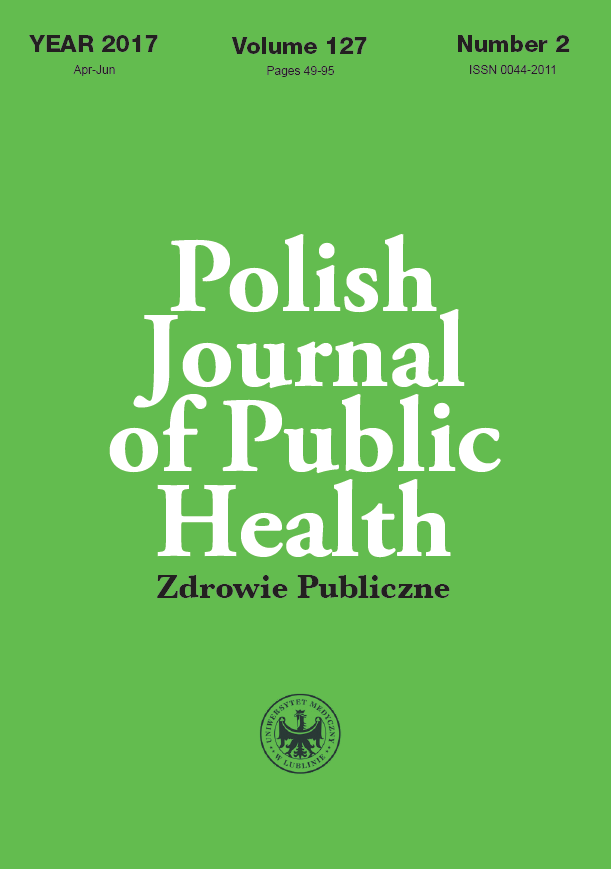What is the pH, Fe and Cl2 content of cosmetics we use? – a pilot study on safety of skin care products
DOI:
https://doi.org/10.1515/pjph-2017-0017Keywords:
pH, iron, chlorine, skin, cosmeticsAbstract
Introduction. The skin is one of the largest organs of the body protecting from external insults in order to maintain homeostasis. It plays many roles: in thermal, electrolyte, hormonal, metabolic, and immune regulation. Proper pH of skin plays a role in creation of skin barrier and resistance to external agents. Cl2 and Fe may irritate skin. If noxious factors are strong, they damage the tissues under the skin. When the insult is severe enough to overwhelm the protective function of the skin, it may manifest itself with acute or chronic skin injury. Therefore, it is important to know if the used skin products are safe.
Aim. The objective of the study was to determine pH, Cl2 and Fe content in selected cosmetics.
Material and methods. A total of 62 skin product samples were collected and divided into 4 groups: I soaps and gels, II hair cosmetics, III creams and balms, IV facial cosmetics. The pH, Cl2 and Fe content in each sample was determined three times and means were calculated. Data were analyzed with one way ANOVA followed by Tukey test. P<0.05 was considered significant.
Results. The pH in group III was significantly higher than in the other groups. Fe content was significantly higher in hair cosmetics as well as in creams and balms. Cl2 content was high in soaps and hair cosmetics.
Conclusions. The majority of the analyzed samples had pH within the healthy range. Traces of Cl2 and Fe present in cosmetics are unlikely to cause skin irritation.
References
1. Sybilski AJ. Skóra – najważniejszy narząd naszego ciała. dbajmy o nią! Pediatr Med Rodz. 2012;8(4):375-9.
2. Yosipovitch G, Maibach H. Departament of Dermatology, UCSF Medical Center, San Francisco, CA, USA. Skin Surface pH: A Protective Acid Matnle. Cosmetics & Toiletries Mag. 1996;111(12).
3. Chomiczewska D, Kieć-Świerczyńska M, Kręcisz B. Kontaktowe zapalenie skóry z podrażnienia. Część III. Nieinwazyjne metody oceny właściwości biofizycznych skóry. Med Pr. 2010;61(4):457-66.
4. Ali SM, Yosipovitch G. Skin pH: From Basic Science to Basic Skin Care. Acta Derm Venereol. 2013;93:261-7.
5. Rice RH, Mauro TM. Toxic Responses of the skin. In: CD. Klaassen, JB.
Watkins III. Casarett & Doull’s Essentials of Toxicology. 2nd ed.New York: Mc Graw Hill Lange; p.267-78.
6. Rubini S, Bonati A, Andreoli G, et al. Chemical and microbiological analysis of cosmetics for hair dyeing and body painting. Tox Let. 2016;258(Suppl):S187.
7. Gawlik MM, Topczewska B, Kurpas D. Quality of life of psoriatic patients – modulatory variables. Fam Med Prim Care Rev. 2016;3(18):235-4].
8. Rippke F, Schreiner V, Schwanitz HJ. The acidic milieu of the horny layer. New findings of the physiology and pathophysiology of skin pH. Am J Clin Dermatol. 2002;3(4):261-72.
9. Ustawa o kosmetykach z 30 marca 2001 r. o kosmetykach, Dz.U. Nr 42, poz. 473 z późn. zm., art. 2 pkt 1. http://isap.sejm.gov.pl/DetailsServlet?id=WDU20010420473 downloaded on Dec12th2016.
10. WHO Guidelines on Hand Hygiene in Health Care. First Global Patient Safety Challenge Clean Care is Safer Care hqlibdoc.who.int/publications/ 2009/9789241597906_eng.pdf downloaded on Dec 8th2016.
11. Smiley RA. Phenylene and Toluenediamines. In Ullmann’s Encyclopedia of Industrial Chemistry, Wiley-VCH, Weinheim; 2002.
12. Jabłońska S, Chorzelski T. Choroby skóry. Warszawa: PZWL; 1994.
13. Sawicki M. Quality of drinking water according to Polish and German directives. Ochr Śr. 1998;3(58):15-8.
14. Directive 98/83/EC – quality of water intended for human consumption. [www.eur-lex.europa.eu]
15. Cosmetics Directive 76/768/EEC.
Downloads
Published
Issue
Section
License
Copyright (c) 2018 Polish Journal of Public Health

This work is licensed under a Creative Commons Attribution-NonCommercial-NoDerivatives 3.0 Unported License.


